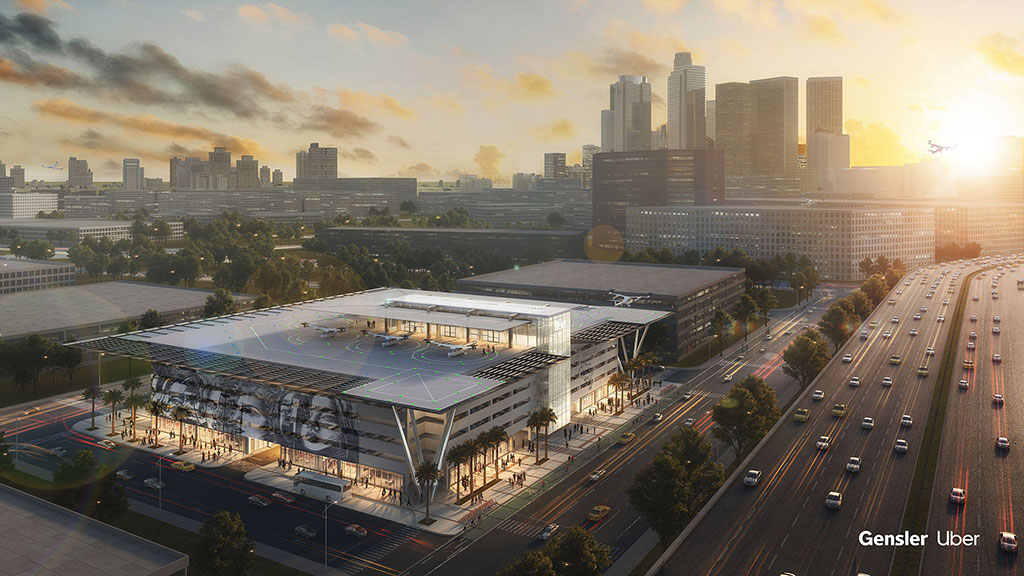How eVTOLs Could Create a More Inclusive, Sustainable Future for Mobility
January 09, 2024 | By Michael Miller
In an era of rapid technological advances, new technologies can come with both a sense of hope and caution, as society imagines how the advances may change our lives. Electric Vertical Take-Off and Landing vehicles (eVTOLs) are one such technology, a long-promised flying car of sorts that could mean large-scale changes to the processes and environments in which we live. As regulators begin to incorporate new technological innovations, the time has come for architects and planners to engage in the transformative effects that advanced air mobility could have on the way we live — both the positives and the negatives. We should ask, perhaps most critically, can this technology help make the world a better place?
What Are eVTOLs?
The current generation of these new flying machines can seat four people and a pilot, but could potentially become autonomous or allow for more passengers in the future. The key technological advancement from a helicopter or a small prop plane are the adjustable propellers that allow vertical takeoff. The craft’s ability to depart a port straight up into the air enables huge possibilities for urban use that were never possible with the flight paths and clearances required for safe use of helicopters or planes. eVTOLs as an advancement from helicopters and small planes offer immediate benefits in significantly reduced sound and fuel pollution on the urban environments below, as the propeller and battery technology offer a clean and quiet ride.
eVTOLs Connecting Mobility, Large and Small
The immediate opportunities to take eVTOLs to market are through expanding the services of current transportation networks at their respective adjacent scales. The aviation industry is looking to expand the next leg of the trip for its customers by allowing transportation from the airport to city hubs or suburban centers. Someday in the future, you may be able to walk to a vertiport in Manhattan, and takeoff for a six-minute flight to JFK International Airport, and enter right into a lounge space for preflight refreshments. eVTOL expansion in regional airports could invigorate underutilized building and runway assets in metropolitan regions, creating a regional network of eVTOL hubs that could connect cities and suburbs. eVTOLs offer more personalized routes, so enabling a network of connectivity much like highways and road networks would allow expanded access to unusual routes. For instance, a trip from Islip on Long Island, New York, to Tweed in New Haven, Connecticut, could cut the corner of highways and ferries by jumping straight across the Sound, potentially creating economic connections that could help both areas grow and benefit.
On the other side of mobility expansion, the rideshare industry is looking to scale up their offerings of taxi services from localized trips to city or regional excursions, serviced by hubs connecting cars, bikes, or public transit to air taxis. Your trip from nearby cities like Seattle to Portland or Pittsburgh to Cleveland could be a taxi service to a vertiport, through the skies, and landing with rideshares waiting for the last mile on the other side. Or a rush-hour traffic trip to the other side of a gridlocked L.A. could consist of an e-scooter to an eVTOL hub and then home via e-bike, skipping over hours of congestion.
Future Mobility Can Learn From the Past
Imagining beyond immediate market opportunities, what potential could eVTOLs hold for future large-scale use? Though eVTOLs offer an exciting prospect of speed, sustainability, and amazing views, architects and city planners should consider the lessons from the past, like how the automobile radically changed urban design.
Despite all the positive aspects of a car, the urban design that resulted enabled sprawl, long commutes, high energy usage, and declines in the sustainable living patterns of public transit and housing density. Car-based urbanism also coincided with and enabled the increase of racially and economically divided neighborhoods. Similar to the automobile, the eVTOL runs the risk of further exasperating economic divides by creating exclusive exurbs of high-energy homes with unsustainable land use.
Flying Toward a More Resilient, Inclusive Future
At a larger scale of adoption, how can the eVTOL create good by improving social equality, ecology, community, and experience? With keen designers and knowledgeable clients, architects and regional planners can build a world using a technology for good while avoiding the pitfalls of the past. eVTOLs can work towards creating an inclusive and sustainable future of mobility for all.
Imagine a future of the flying vehicle where vertiports are central community assets, surrounded by high density housing linking to walkable neighborhoods and public transportation. An optimistic future could see costs low enough and crafts large enough to relieve the strains of high housing costs and allow people to commute quickly and sustainably. Dense towns could exist among protected forests or regional cities could be invigorated with fast commutes to a major metropolis.
What if transportation shifting to the skies could free the ground? Urban or suburban highways could be filled in as parkland, with eVTOLs flying above. Humans, forests, and animals could use the reclaimed land to connect back together. In U.S. cities where highways were used as tools of segregation, neighborhoods could be rejoined with a meeting place in between, while fauna flourishes, and migration paths are reopened. The key to this path of social and ecological healing is to take care not to create a system of vertical social divides between ground and sky, while healing the horizontal planes below. Access to these spaces and use of sustainable transit will be crucial.
If more transit shifts to the skies, eVTOLs could provide an alternative to the physical and financial roadblocks faced in the buildout of a high-speed rail network. eVTOLs could fly above the rail corridors at high speeds and into central city hubs, creating a new type of Grand Central, with the ‘tracks’ in the sky instead of below ground. Rail transit compliments cities by injecting mobility and regional networks directly into city centers. In the same ways that rail transit enables vibrant and sustainable cities, the eVTOL’s ability to connect places at their centers could yield a new type of urban flourishing that connects people to a future of sustainable mobility.
For media inquiries, email .

